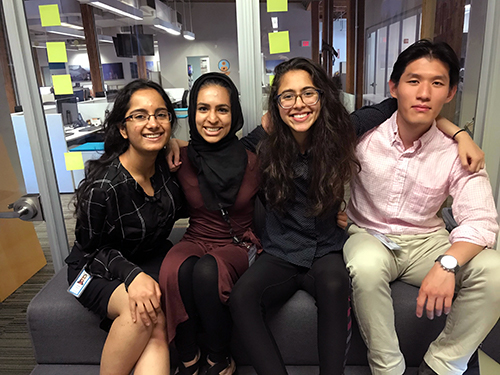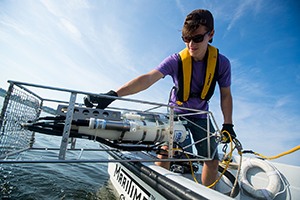PROVIDENCE, R.I. [Brown University] — Even as a young child, Azeeza Hasan knew mathematics would play a big role in her life.
“I was reading about math when I was 9 years old,” she said. “There wasn’t really another answer. It was always math.”
How she might apply her passion to a career, however, was for many years a mystery.
“I didn’t want to sit at a desk proving theorems without having human interaction,” Hasan said, “and that’s why applied math, rather than pure math, intrigued me. I knew I was also interested in things like aerospace, computer science and machine learning — so the applied math program at Brown attracted me.”
With an applied math degree, Hasan explains, the possibilities are endless. A student who learns how to apply math to biology, for example, could go on to create models that help medical professionals understand, diagnose and treat diseases. A student who pairs applied math with aerospace could later end up at NASA, designing and executing missions to Mars — something Hasan learned last year in an internship with the Virginia Space Grant Consortium at NASA’s Langley Research Center.
This summer, with her junior year at Brown set to begin in September, Hasan wanted to explore the possibilities at the intersection of math and finance — so she took an internship at NASDAQ’s Global Technology Center in Boston. The stock exchange presented Hasan and nine other interns with a rather staggering task: to create and pursue a patent for a streamlined, smart online marketplace for buyers and sellers, one that lets individuals and industries discover fair prices and make more informed purchase decisions.
Hasan said NASDAQ executives gave the interns a broad overview of the company’s idea at the start of the experience. Then they walked out the door, leaving the students to design and execute a master plan that would bring its vision to life.
“It’s amazing how much autonomy they’re giving us,” Hasan said. “They really wanted fresh minds to take on this vision and find out how it can manifest as a product. If I want to create an algorithm because I think it’ll help us, I can just do it.”
The first week, Hasan said, was one extended brainstorm. The team’s enormous whiteboard was covered with ideas, use cases, pros and cons. In the second week, they voted on the best ideas, honed them and finalized a master plan. They established weekly goals and instituted daily “stand-up” meetings, where students state their immediate goals and communicate any issues they are working through.

At first, Hasan felt intimidated: Many fellow interns “probably came out of the womb coding,” she joked. Hasan, on the other hand, had no computer science knowledge before coming to Brown. But the Washington, D.C., area native soon realized she brought her own unique set of skills. Earlier this summer, for example, she discovered she was most familiar with a certain algorithm their team needed, so she gave her peers an impromptu lesson.
“I’m realizing every day I’m away from Brown how helpful applied math has been,” she said. “I’ve sent my professors emails saying, ‘You made me look good in front of these full-time employees!’”
While Hasan doesn’t know whether she’ll end up in aerospace, finance or another sector entirely, she’s certain this summer’s experiences will serve her well for years to come.
“We’ve been functioning like a startup company, so I’ve learned as much about collaborating as I have about coding and algorithms,” she said. “It’s been an amazing learning experience.”
